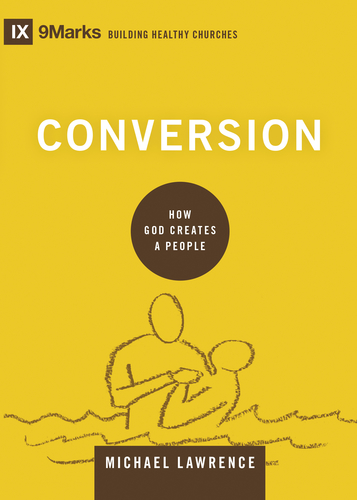I was first introduced to the Building Healthy Churches series of books from 9Marks through J. Mack Stiles’ excellent title, Evangelism. I was honestly blown away by all that was covered in that small volume. Since then, I have read several volumes in this series and have not been disappointed with any of them.
In Conversion, Michael Lawrence continues the tradition of solid work within this series. The subtitle of the book says much about the direction of the author: how God creates a people. Thus, the main idea here is that conversion is the process that God uses to build up his church and create his people.
The book is divided into eight short chapters that could each be easily read in one sitting. In the first chapter, Lawrence focuses on the necessity of regeneration in conversion. The gospel came to make us new, not not better and not nice. The gospel brings the dead to life.
From there he goes on to explain that salvation must be understood as the work of God in the life of a believer and that God’s work continues throughout the believers life. God is working to make his children holy. That sanctifying work of holiness doesn’t happen overnight, but for all children of God it is happening. As he speaks of sanctification, he also urges against therapeutic approaches to the gospel warning,
When our churches slip into a therapeutic gospel, we treat the Christian life less as a battle against sin and more as a battle to feel accepted. We stop singing the old hymns about sanctification and perseverance, and sing instead the romanticized lyrics that trade heavily in images of Jesus’ closeness, embrace, and tender touch…the therapeutic gospel teaches us to love the indicatives of the gospel, but to avoid the imperatives of the gospel, and to read both the indicative and the imperative throughout he lens of my own happiness (71).
Conversion is much more than therapy, it is new life and initiation into a new people living under the rule of a different king,
In the therapeutic gospel, Jesus has come to fill the void in your heart. In the biblical gospel, he has come to establish his lordship over your life.
Lawson also does a very good job of explaining the implications of the gospel for building up the local church in chapter five, Distinct not Designed. Healthy churches are united through the gospel irrespective of socio-economic, political, racial, or other barriers. The church is distinct because of the work of Christ, but it is not designed.
Finally, Lawrence may have saved the best for last. In all honesty, nothing in the first seven chapters of the book is earth-shattering. It is all good, concise, and well-written, but it is also available in one form or another in a whole variety of other books. In chapter eight, however, he covers a subject I have never before seen in a book; he warns against the overly pure church.
In a time when church-discipline is being recovered and regenerate church membership discussed, one of the criticisms is that no one really knows the heart of another, or what do we do with those who seem to be straddling the line?
Lawrence makes a compelling argument that the church should bear with the immature and should extend wide latitudes of grace regarding who should be admitted to membership. For instance, there is a significant difference between a sister who is struggling in sin, but with each failure grows in repentance and moves closer toward holiness and a hypocrite who hides and lies without hoping in Christ, even though “outwardly they look fine.” With the exception of the “scandalous,” those who live in public, blatant, unrepentant sin, every effort should be made to extend charity to those who claim to be in Christ. After all,
Hope in Christ demonstrates itself in a trajectory of growth, not by having already arrived. It’s seen in a willingness to be taught, not in already knowing everything. It struggles against sin; it’s not at ease in Zion (Amos 6:1). It limps with the wounds of battle, but limping on it goes. And it holds on to the trustworthy saying “that Christ Jesus came into the world to save sinners, of whom I am the foremost” (1 Timothy 1:15).
My expectation was to read a book on conversion, which this was, but it was more. This is a great book on ecclesiology as well, on the relationship of conversion within the church.
Notable Quotes:
- Regeneration gives us a heart not only for God, but also for God’s people (28).
- The Bible doesn’t say “Be sincere”; it says, “Be saved” (e.g., Acts 2:21) (33).
- But what happens when we think faith saves us? Sincerity becomes paramount. We begin to think of faith as a single act–a prayer prayed, a decision made, a card signed, a hand raised–rather than as a whole-life orientation (37).
- Repentance is not a feeling (52).
- Saving faith clings to Christ and doesn’t let go. And like repentance, it leaves evidence throughout a believer’s life (57).
- So holiness matters because it reveals who our master is (73).
- Real conversions–conversions characterized by repentance and given by God–bear up under suffering (93).
- Remember that relationships are as much or more about encouragement than they are accountability (107).
- If Christ does not reject the repentant murderer, or homosexual, or child abuser, can we (117)?
- The local church is God’s evangelism plan for the world (127).


